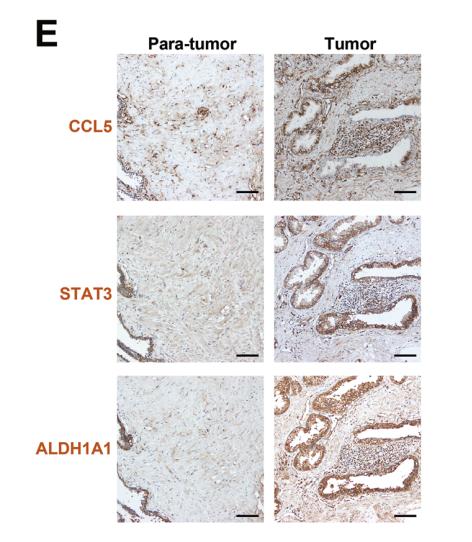产品描述
*The optimal dilutions should be determined by the end user.
*Tips:
WB: 适用于变性蛋白样本的免疫印迹检测. IHC: 适用于组织样本的石蜡(IHC-p)或冰冻(IHC-f)切片样本的免疫组化/荧光检测. IF/ICC: 适用于细胞样本的荧光检测. ELISA(peptide): 适用于抗原肽的ELISA检测.
引用格式: Affinity Biosciences Cat# DF7427, RRID:AB_2839365.
展开/折叠
Beta chemokine RANTES; Beta chemokine RANTES precursor; C C motif chemokine 5; CCL 5; CCL5; CCL5_HUMAN; Chemokine (C C motif) ligand 5; Chemokine CC Motif Ligand 5; D17S136E; EoCP; Eosinophil chemotactic cytokine; MGC17164; RANTES(4-68); Regulated upon activation normally T expressed and presumably secreted; SCYA 5; SCYA5; SIS delta; SIS-delta; SISd; Small inducible cytokine A5 (RANTES); Small inducible cytokine A5; Small inducible cytokine subfamily A (Cys Cys) member 5; Small-inducible cytokine A5; T cell specific protein p288; T cell specific RANTES protein; T cell-specific protein P228; T-cell-specific protein RANTES; TCP 228; TCP228;
抗原和靶标
Expressed in the follicular fluid (at protein level). T-cell and macrophage specific.
- P13501 CCL5_HUMAN:
- Protein BLAST With
- NCBI/
- ExPASy/
- Uniprot
MKVSAAALAVILIATALCAPASASPYSSDTTPCCFAYIARPLPRAHIKEYFYTSGKCSNPAVVFVTRKNRQVCANPEKKWVREYINSLEMS
种属预测
score>80的预测可信度较高,可尝试用于WB检测。*预测模型主要基于免疫原序列比对,结果仅作参考,不作为质保凭据。
High(score>80) Medium(80>score>50) Low(score<50) No confidence
翻译修饰 - P13501 作为底物
| Site | PTM Type | Enzyme | Source |
|---|---|---|---|
| S27 | O-Glycosylation | Uniprot | |
| S28 | O-Glycosylation | Uniprot | |
| K68 | Ubiquitination | Uniprot |
研究背景
Chemoattractant for blood monocytes, memory T-helper cells and eosinophils. Causes the release of histamine from basophils and activates eosinophils. May activate several chemokine receptors including CCR1, CCR3, CCR4 and CCR5. One of the major HIV-suppressive factors produced by CD8+ T-cells. Recombinant RANTES protein induces a dose-dependent inhibition of different strains of HIV-1, HIV-2, and simian immunodeficiency virus (SIV). The processed form RANTES(3-68) acts as a natural chemotaxis inhibitor and is a more potent inhibitor of HIV-1-infection. The second processed form RANTES(4-68) exhibits reduced chemotactic and HIV-suppressive activity compared with RANTES(1-68) and RANTES(3-68) and is generated by an unidentified enzyme associated with monocytes and neutrophils. May also be an agonist of the G protein-coupled receptor GPR75, stimulating inositol trisphosphate production and calcium mobilization through its activation. Together with GPR75, may play a role in neuron survival through activation of a downstream signaling pathway involving the PI3, Akt and MAP kinases. By activating GPR75 may also play a role in insulin secretion by islet cells.
N-terminal processed form RANTES(3-68) is produced by proteolytic cleavage, probably by DPP4, after secretion from peripheral blood leukocytes and cultured sarcoma cells.
The identity of the O-linked saccharides at Ser-27 and Ser-28 are not reported in. They are assigned by similarity.
Secreted.
Expressed in the follicular fluid (at protein level). T-cell and macrophage specific.
Belongs to the intercrine beta (chemokine CC) family.
研究领域
· Environmental Information Processing > Signaling molecules and interaction > Cytokine-cytokine receptor interaction. (View pathway)
· Environmental Information Processing > Signal transduction > TNF signaling pathway. (View pathway)
· Human Diseases > Neurodegenerative diseases > Prion diseases.
· Human Diseases > Infectious diseases: Bacterial > Epithelial cell signaling in Helicobacter pylori infection.
· Human Diseases > Infectious diseases: Parasitic > Chagas disease (American trypanosomiasis).
· Human Diseases > Infectious diseases: Viral > Influenza A.
· Human Diseases > Infectious diseases: Viral > Herpes simplex infection.
· Human Diseases > Immune diseases > Rheumatoid arthritis.
· Organismal Systems > Immune system > Chemokine signaling pathway. (View pathway)
· Organismal Systems > Immune system > Toll-like receptor signaling pathway. (View pathway)
· Organismal Systems > Immune system > NOD-like receptor signaling pathway. (View pathway)
· Organismal Systems > Immune system > Cytosolic DNA-sensing pathway. (View pathway)
文献引用
Application: IHC Species: human Sample: prostate cancer cells
限制条款
产品的规格、报价、验证数据请以官网为准,官网链接:www.affbiotech.com | www.affbiotech.cn(简体中文)| www.affbiotech.jp(日本語)产品的数据信息为Affinity所有,未经授权不得收集Affinity官网数据或资料用于商业用途,对抄袭产品数据的行为我们将保留诉诸法律的权利。
产品相关数据会因产品批次、产品检测情况随时调整,如您已订购该产品,请以订购时随货说明书为准,否则请以官网内容为准,官网内容有改动时恕不另行通知。
Affinity保证所销售产品均经过严格质量检测。如您购买的商品在规定时间内出现问题需要售后时,请您在Affinity官方渠道提交售后申请。产品仅供科学研究使用。不用于诊断和治疗。
产品未经授权不得转售。
Affinity Biosciences将不会对在使用我们的产品时可能发生的专利侵权或其他侵权行为负责。Affinity Biosciences, Affinity Biosciences标志和所有其他商标所有权归Affinity Biosciences LTD.

